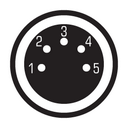DMX512, often abridged to DMX (Digital MultipleX), is a communication protocol used mainly to control stage lighting. It is a type of the RS-485 architecture. Developed by the Engineering Commission of USITT, the standard took off in 1986 with subsequent revisions in 1990 leading to USITT DMX512/1990. ESTA took control of the standard in 1998 and started an additional revision process. The new standard, officially known as "Entertainment Technology — USITT DMX512–A — Asynchronous Serial Digital Data Transmission Standard for Controlling Lighting Equipment and Accessories", was approved by ANSI in November, 2004.
DMX was originally intended as a replacement for 0-10V lighting control for usage in linking controllers and dimmers of different manufacturers; a protocol to be used as a last choice after trying more proprietary methods. However, it soon became the primary method for not only linking controllers and dimmers, but also linking more advanced fixtures and special effects devices, such as fog machines and moving lights. DMX512 is unidirectional and does not allow for a response. Therefore, it must not be used for any type of utilization involving one's safety, such as controlling pyrotechnics. MIDI is sometimes used for this very task.
A DMX512 controller is connected to fixtures or devices in a so-called daisy-chain linkage. Each device has a DMX-IN and usually a DMX-OUT connector-sometimes labeled as DMX-Thru. The DMX-OUT port of the controller is linked via a DMX512 cable to the DMX-IN of the first fixture. A second cable then links the DMX-OUT of the first fixture to the next device, and so forth. In general, the last DMX-OUT connector, which is not connected, should have a DMX512 terminating plug attached to it. This simply is a 120O resistor joining together pin 2 and 3 of the connector. Many modern devices neglect this requirement because they are capable of auto-terminating the link.
The connectors themselves should be five-pin XLRs. Nevertheless, only three pins of the five are used. Many manufacturers use three-pin XLR connectors, in violation of the Standard. Additionally, with the approval of the DMX512-A standard Cat5-cabling is also an acceptable wiring topology if used in a permanent installation.
Only cables designed for utilization with DMX512 should be used. Testing by ESTA has shown that CAT5 cables may be used without any compromise of signal quality. However, due to the common usage of three-pin XLR connectors, microphone cables are often used for DMX512 purposes and this is certainly not a recommended practice.
Data Plus (pin 3) and Data Minus (pin 2) are reversed in comparison to sound cables. Hence, the signal travels in the opposite direction to the pins (female is out, male is in). The pin layout of a female connector is the following:
Pin Layout
|
#1 Ground #2 Data - #3 Data + #4 Spare (or Data2 -) #5 Spare (or Data2 +) |
